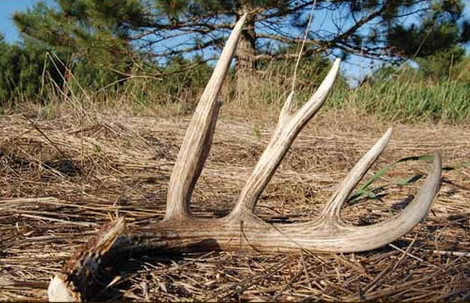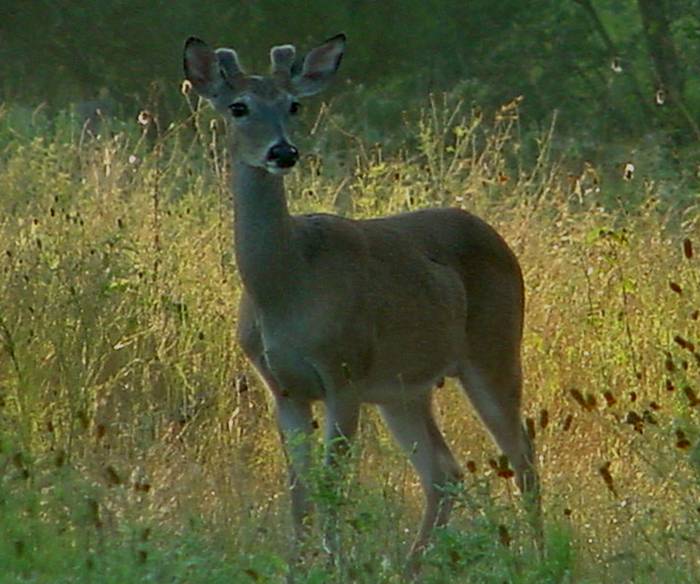White-tailed deer shed their antlers every year prior to the re-growth of new ones. It may surprise you to find out that the entire shedding process takes only two to three weeks to complete, and of course the re-growth phase takes place over the summer up into very early fall.
Bucks have antlers throughout spring, summer, and most of the winter, but shed them sometime between January and April (depending upon the animal and latitude), after the rut and breeding season comes to an end. A buck can carry-on without antlers post-breeding because they do not need to fight-off other bucks for territory and does.

Antler Loss
Deer antlers differ from the hollow horns of cattle in that they comprise solid bone tissue with a honeycombed structure. Pedicles, the skin-covered nubs protruding from a buck’s skull, serve as a base for antler growth and support the deer’s antlers. However, keep in mind that the pedicles are permanent fixtures on the deer’s forehead, and are the point at which antlers separate from the deer each year.
During the first 6 to 8 months of age, the pedicles grow and begin to appear on a buck fawn‘s forehead. These young bucks, born earlier in the year, are commonly referred to as “nubbin bucks” by hunters. A whitetail buck actually begins antler growth as a yearling buck (first set of antlers) at about 1 year of age. Each subsequent year the buck will go through the antler growing process and loser its antlers, over and over, annually. As the deer matures, the antlers typically increase in mass, beam length, and point length. They also will add points in many cases, but not always.
Growing Antlers to Use, then Lose
During growth, antlers are covered with a sensitive skin commonly referred to as “velvet.” This velvet is filled with blood vessels that constantly feed the antlers the vitamins and the minerals necessary for bone building. Antler growth demands a lot of vitamins, minerals, protein, and energy, so adequate native forage and/or supplemental feed must be available to meet these requirements for maximum antler growth in bucks.
Antler growth can range from two to four months depending upon the individual buck. After this time, a hardened ring forms at the base of the antlers (burr) that shuts off blood flow to the velvet-covered antlers. As a result, the velvet deteriorates, dries up, and falls off, often assisted by the white-tailed buck, which rubs his antlers against tree bark.
At this point, the antler growing cycle of a whitetail buck is complete. The buck will prepare for the breeding season, and then antler shedding cycle will resume after the fall and winter breeding season. After the weather warms and Spring green-up, bucks across the whitetail’s range will start a whole new year of antler growth.



I live in Richmond County which is Staten Island, New York. I live on the most southern side of the island closest to Perth Amboy, New Jersey. The whitetail deer swim over from Jersey. There is an over abundance of them here now I see them I walk my dog at night. Anyone know when bucks shed there antlers around here. I love to find some sheds. Thanks!
It isn’t only rodents that eat antlers. Most bucks will eat their own antlers for the calcium. I have seen them more than once in my own woods in Minnesota.
Bill, good call. A number of animals will go for calcium-rich antlers in areas where it’s lacking. I imagine antlers are sought out by a number of animals on soils that are acidic.
Why do whitetail deer horns appear chocolate colored in the winter time?
Peggy, a whitetail buck’s antlers can range in color depending on the deer and its location. Some antlers appear almost white and others more dark. The biggest factor is what they tend to rub them on. When the velvet comes off there is often blood present. This can combine with sap and make various colors, typically tan to dark brown. Bucks that have nothing to rub antlers on will have white antlers.
Even the old bucks that have 13 points lose their antlers each year? If so, will they grow the 13 points back? How old would you think a deer with that many points be? I don’t know if he’s still around. He also had a white face.
Patti, yes, all whitetail buck shed their antlers annually. Well, all except stag bucks, which typically are bucks that have injured themselves (testicles). Generally speaking, antler points do increase within a particular deer as it ages, but there is no rule here. Some bucks have 2 points their first set of antlers, some have 10, but most free-ranging mature bucks have 10 or fewer points.
Isn’t true that once deer antlers harden, their testicles drop down and now are ready for breeding?
Antler growth ceases and velvet falls off as a result changes in melatonin (and resulting testosterone) levels in bucks, which occurs just prior to the breeding season. The testicles of a buck do not go up and down like a garage door, but studies have found that semen viability does increase after bucks shed.
When do deer shed their antlers in Northern Florida?
Dog Lover, white-tailed deer are quite uniform across their range. Deer in that area will shed their antlers starting in late January through early April, depending on body condition. Most shedding activity will take place in February and March.
After the buck sheds it’s antlers, are the nubs still obvious? I have a few deer around my home and I’m pretty sure they’re doe’s (no visible nubs). Am I right?
Tenderfoot, bucks will still have pedicles (bases where antlers grow) visible on each side of the top of their heads. In addition, bucks are generally/physically larger and more muscular than does. It sounds like you have does hanging out around your house.